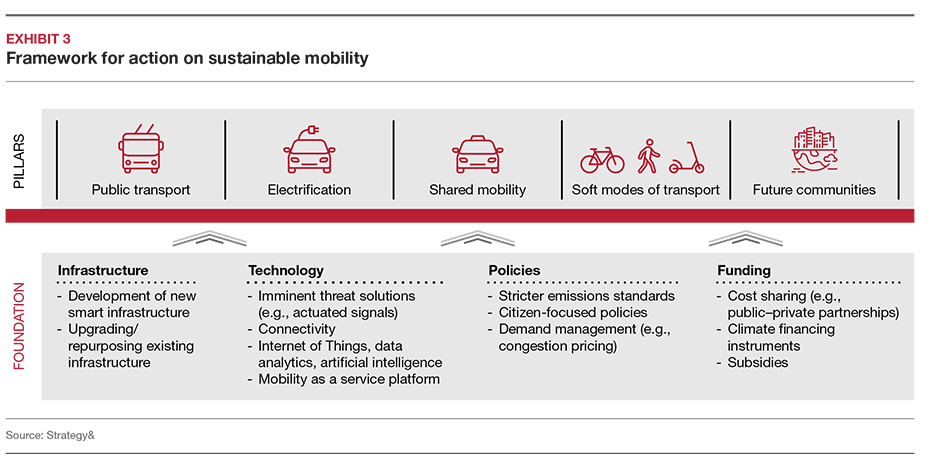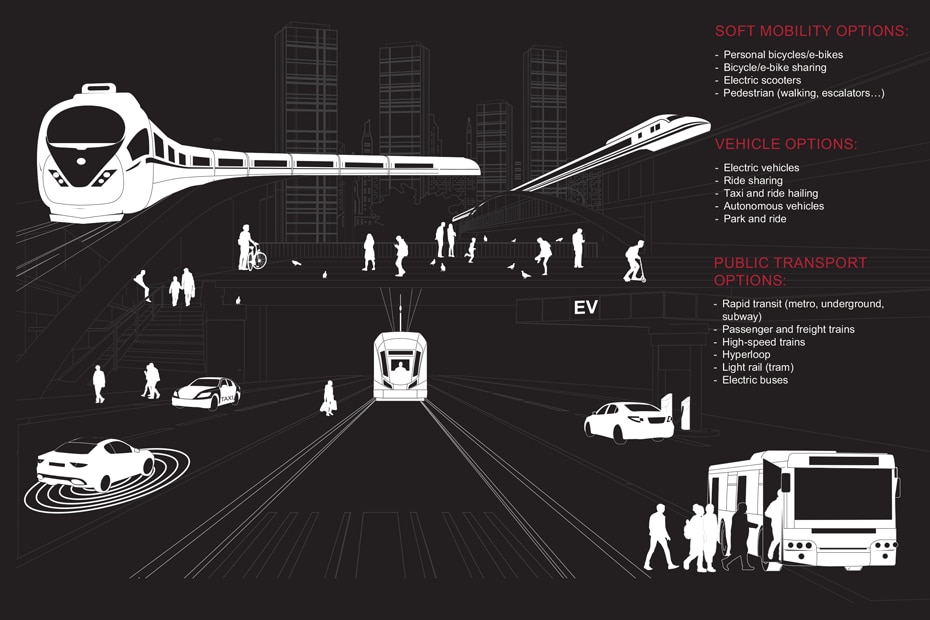{{item.title}}
{{item.text}}

{{item.title}}
{{item.text}}
The countries of the Gulf Cooperation Council (GCC) are building sustainability targets into their national development plans. To succeed, they must focus on transportation and mobility as a core element in these efforts. Most transportation in the region, particularly in cities, is dominated by road infrastructure and privately owned vehicles, leading to considerable CO2 emissions, congestion, and the consequent economic costs. This prevents countries from achieving their sustainability goals.
To reverse this trend, several GCC cities are investing heavily in building new, and modernizing existing, public transport systems including new metro, tram, and bus networks. Some also have ambitious goals to adopt leading smart mobility technologies within the next decade. However, we believe governments must aspire to more. They need a comprehensive framework that will “invert the transport pyramid,” de-emphasizing privately owned cars and expanding public transport, along with electric- and hybrid-powered cars and trucks, vehiclesharing programs, and micromobility solutions such as bicycles and scooters.
Such a comprehensive framework has two main effects. It can ensure that people and goods move around in a self-sustaining, intelligent, and carbon-neutral way. We also forecast that it can unlock about US$400 billion in economic value over the next 20 years.
This comprehensive framework rests upon five pillars: public transport, electrification, shared mobility, soft modes of transport, and future communities. Supporting these pillars is a foundation composed of four elements: infrastructure, technology, policies, and funding.
Governments in the GCC have ambitious goals to reduce greenhouse-gas emissions and improve sustainability overall. However, they have made limited progress in terms of sustainable mobility, particularly in the region’s cities. The mobility sector contributes about one-fourth of CO2 emissions worldwide, placing the sector at the heart of any national sustainability agenda.
Most municipal designs in the GCC still prioritize privately owned vehicles, with other forms of personal transport less popular and less important from a policy standpoint. To meet ambitious sustainability agendas, governments should aspire to “invert the transport pyramid,” deprioritizing private cars and giving greater emphasis to alternate forms of transportation. These include public transport, vehicle sharing, electric and hybrid powertrains, and lessenergy-intensive modes of transport such as bicycles, scooters, and walking (see Exhibit ).
Inverting the pyramid in this way requires a comprehensive framework, building next-generation transport systems and integrating technology and sustainable thinking into policymaking, urban planning, and infrastructure development.
GCC countries need to adopt a comprehensive framework consisting of five pillars on a foundation of four enabling elements to modernize the transportation sector sustainably (see Exhibit ).
The five pillars represent different solutions that affect transportation.
Public transport
A multi-modal, integrated, and robust public transport system is central to sustainable mobility systems. Governments should continue to invest in these systems, with the goal of eventually shifting to a fully electric fleet. Advancing public transport ridership has allowed urban areas across the globe to overcome many less-than-efficient mobility and societal outcomes.
Electrification
Governments should enable and incentivize greater adoption of EVs. In 2020, 3.2 million EVs were sold worldwide, up 43 percent over 2019, during a pandemic and an economic slowdown, when the overall car industry shrank by 14 percent.
Shared mobility
Cities can move commuters more efficiently by reducing the reliance on personal vehicles and using shared mobility solutions to increase riders per vehicle. The market expansion of ride-hailing players has proven that shared mobility as a business model works well within a lightly regulated market, while improving asset utilization.
Soft modes of transport
Micromobility solutions can increase the options for urban residents and increase usage of public transport by addressing first-mile and last-mile connection challenges. City governments should continue to deploy such alternatives as bike-sharing and e-scooters in major cities.
Future communities
Governments can reduce the need for transportation through sustainable urban designs that use new living and community concepts to make vital goods and services available within walking distance from residential areas. Roshn and the Line at NEOM in Saudi Arabia are good examples of this approach.
Established GCC cities can start by creating “sustainable mobility districts.” These would be new developments with carbon-neutral transportation modes, drones for delivery, work from home options, and variants of e-scooters and e-cycles. Dedicated test areas can also be created within certain parts of the city, such as running an autonomous shuttle on dedicated low-risk lanes connecting multiple tourist spots. This can validate the increased safety, sustainability, and accessibility benefits and train the automated vehicle algorithms on GCC-specific terrain and traffic conditions, paving the way for wider adoption.
GCC countries have taken important steps to build sustainability into their national development. They must now apply this approach to the mobility sector. By “inverting the transport pyramid,” governments can improve their sustainability performance, making GCC cities safer, healthier, and more economically relevant for today’s residents and future generations.







Menu